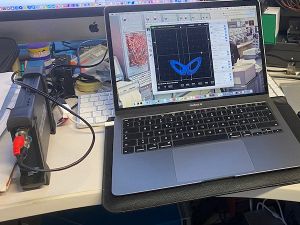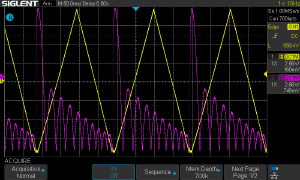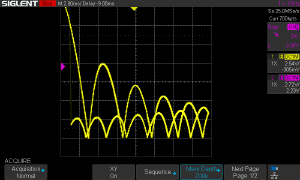Oscilloscope
An Oscilloscope is an essential measurement device when doing analog computing. Nevertheless, even cheap entry level devices cost more than 200 EUR. This page shall document how to use oscilloscopes with THAT and gives recommendations about devices that are suitable for working with The Analog Thing. If you don't want to spend money on an oscilloscope, a Software Oscilloscope maybe an alternative.
Using Oscilloscopes
To watch and measure the values and curves produced during an analog computation or simulation you need additional instruments. The Analog Thing contains a voltmeter as instrument to setup the coordinates or OP_TIME values. Depending on the mode of operation in REP with predefined operation time or OP with infinite operation this display may be useful for static or slow moving values only.
To measure faster events or display signal curves the best tool is an oscilloscope. For longer operation times (REP, 0.1-10s) a digital storage oscilloscope (DSO) is preferred rather than an analog oscilloscope with a cathode ray tube (CRT). These DSO did get cheaper in the last years but useful DSO's with minimum 2 channels and XY mode are in the price range of about 150-300 € up. XY mode is useful for many applications and allow a better view of complex signals than displaying them just over the time in Yt mode. The typical Lissajous figures for example require the XY mode.
There are low cost oscilloscope on the market as well in the range of 40-100 € but these come with missing features and have mostly only one channel to display like DSO 138 or missing XY mode like DS 212/213. This is only partly useful with analog computations or simulations and all theses cheap handhelds have only a very small display. Some low cost oscilloscopes come without a display and are connected to a computer as display by software.
Requirements for Oscilloscopes with The Analog Thing

Minimum requirements (cheap devices)
- analog oscilloscope with CRT display or software display while connected to computer
- 1 or 2 channels
- XY display mode
- 100 kHz bandwith
Recommendations:
- Hantek USB DSO (79€ entry price)
- Picoscope (125€ entry price)
- Analog Discovery 2 (280€ for academic)
- ADMAL2000
Further cheap alternatives:
- HS101 http://hscope.martinloren.com/HS101-oscilloscope.html
- DroidOscillo https://hackaday.io/project/26360-android-oscilloscope-droidoscillo
- DSO-138 https://www.reichelt.de/dso-138-oszilloskop-1-kanal-200-khz-12-bit-joy-it-dso-138-p209775.html?&trstct=pol_0&nbc=1
- SmartScope https://www.kickstarter.com/projects/751733865/smartscope-reinventing-the-oscilloscope
- FNIRSI 1014D DSO https://www.youtube.com/watch?v=yQKuHJELEOs
Medium requirements
- 4 channels or separate trigger input
- DSO type (digital storage)
Recommendations:
- Siglent SDS1000X-E (about 400€)
Alternatives
A cheap alternative for beginners with low budget is to use a Software Oscilloscope. These solutions rely on your computer for all of the data processing and use a secondary device (such as an Arduino or sound card) for data acquisition.

